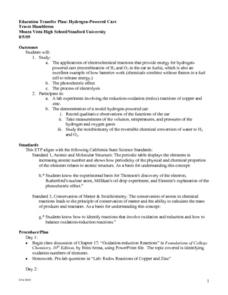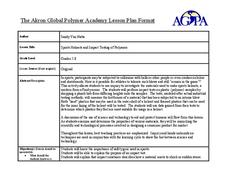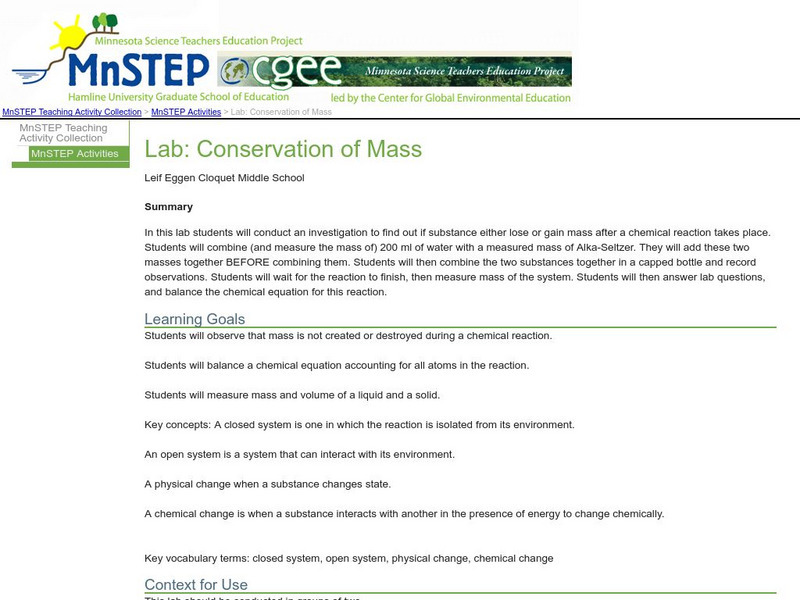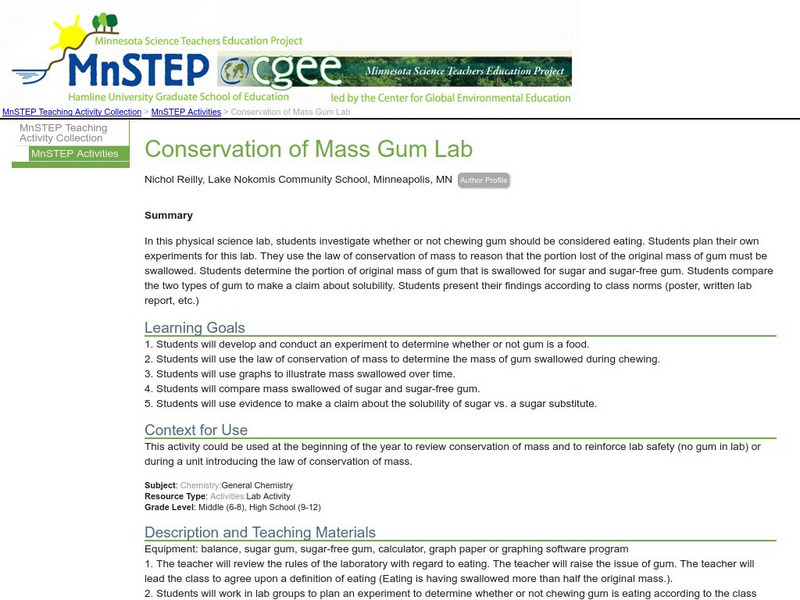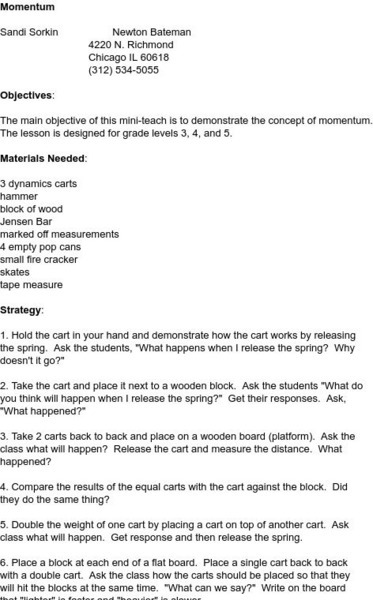Curated OER
How Much Energy is Stored in Wood?
For this energy lesson, students create calorimeters out of soda cans and use them to calculate the amount of energy stored in different types of wood.
Curated OER
Hydrogen Powered Cars
Students apply the principles of chemistry to investigate the concept of how a hydrogen powered car works. They study the electrochemical reactions that provide the energy source. Students also record observations in the functioning of a...
Curated OER
Sports Helmets and Impact Testing of Polymers
Students examine the importance of good quality safety gear. In this investigative instructional activity, students will tests various polymers, collect data, and analyze the data to determine which polymer is best for safety helmets....
Curated OER
What Happens When Chemical Are Put Together?
In this chemical reactions worksheet, high schoolers answer 20 multiple choice questions about chemical equations, chemical formulas, oxidation and reduction reactions and acids, bases and salts.
Curated OER
THe Decomposition of Water
Students collaborate in an experiment where they decompose water into simpler substances through the process of electrolysis. They collect, measure, and observe data and then place the data into a table. Accomodations for students with...
Curated OER
Limiting Reagent
Students work in small groups with a small set of 8 nuts and 5 bolts to assemble into combinations of 1 nut: 1 bolt, and 2 nuts: 1 bolt. They explore the outcome and discuss. Then a student mixes two clear, colorless solutions together...
Curated OER
Thermal Energy and Heat Unit
Young scholars explain that heat energy in a material consists of the disordered motions of its atoms or molecules. They know and explain that transformations of energy usually transform some energy into the form of heat, which...
Curated OER
Latex Helium Balloons: Any Alternatives?
Students discuss the latex balloon release controversy and review suggested alternatives to the latex balloon.
Science Education Resource Center at Carleton College
Serc: Lab: Conservation of Mass
This lab experiment shows students that mass is not gained or lost during a chemical reaction. Lab also includes a set of lab questions that requires students to balance the chemical equation for the reaction that occurs in this lab.
Science Education Resource Center at Carleton College
Serc: Conservation of Mass Gum Lab
Students investigate whether or not chewing gum should be considered eating using the law of conservation of mass to reason that the portion lost of the original mass of gum must be swallowed.
Science Education Resource Center at Carleton College
Serc: Mn Step: The Disintegration of Polystyrene Lab
A lab activity where students investigate the structure of polystyrene by breaking down the cross-links between bonds using acetone. The experiment will help them to understand how mass is conserved despite the drastic change in volume,...
University of Colorado
University of Colorado: Ph Et Interactive Simulations: Pendulum Lab
An interactive simulation that teaches about periodic motion, simple harmonic motion, and conservation of energy. Observe one or two pendulums to determine how the swing is influenced by the length of the string, the mass of the pendulum...
University of Colorado
University of Colorado: Ph Et Interactive Simulations: Masses & Springs
An interactive simulation that teaches about springs, Hooke's Law, and conservation of energy observing changes in kinetic, potential, and thermal energy by adjusting the stiffness and damping of springs holding various masses. This...
University of Colorado
University of Colorado: Ph Et Interactive Simulations: Masses & Springs
Hang various mass weights on spring scales while you adjust the spring stiffness and damping in this online activity. Slow down the action, take it to another planet, or watch the amount of potential, thermal, and kinetic energy.
University of Colorado
University of Colorado: Ph Et Interactive Simulations: Pendulum Lab
Manipulate the mass of a weight and the length of string in this interactive pendulum simulation. Change the speed, friction, and gravity to make the pendulum swing change as measurements are displayed on the screen. Younger students can...
University of Colorado
University of Colorado: Ph Et Interactive Simulations: Masses and Springs
Use this interactive, animated lab to explore conservation of mechanical energy.
Science Education Resource Center at Carleton College
Serc: Chemical Changes: Reacting an Acid and Base
In this chemistry lab, students will investigate chemical changes that occur when acids and bases react. It is meant to introduce the concepts of chemical changes, gases have mass, conservation of mass, and balancing equations. Students...
Science and Mathematics Initiative for Learning Enhancement (SMILE)
Smile: Momentum Conserved
This site by the Illinois Institute of Technology gives a Lab activity in which young scholars use a variety of toys to discover Newton's second law and momentum conservation. Newton's cradle, skate boards, and a toy motorcycle are...
Annenberg Foundation
Annenberg Learner: The Habitable Planet: Unit 9: Biodiversity Decline
This is an extensive learning module on biodiversity and its decline. It looks at ways biodiversity is threatened, the possibility of another mass extinction, the causes and consequences of habitat loss, factors that drive biodiversity...
Science and Mathematics Initiative for Learning Enhancement (SMILE)
Smile: Momentum
Lesson plan to be used for grades 3-5. Does require a Jensen Bar, dynamic carts, firecrackers, and pop cans. Change the masses of the carts to compare and contrast momentum.
Science and Mathematics Initiative for Learning Enhancement (SMILE)
Smile: Colliding Spheres
This lab activity from the Illinois Institute of Technology lets students investigate the impact of collisions upon the velocity and momentum of the colliding objects. Requires understanding of vectors.



